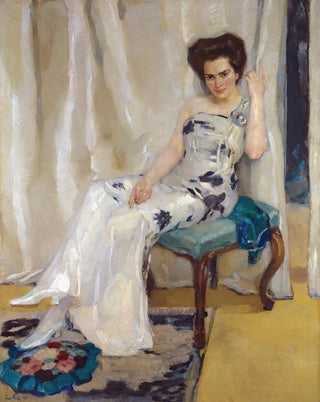Art print | Cara Sophia Köhler and Goldammer - Leo Putz


View from behind

Frame (optional)
In the fascinating world of art, some works manage to capture the very essence of human emotion. The art print Cara Sophia Köhler and Goldammer - Leo Putz is a perfect example. This painting, with its delicate composition and vibrant colors intertwining to create an atmosphere that is both intimate and universal, invites the viewer to immerse themselves in a universe where beauty and sensitivity meet. By delving into this piece, one feels a surge of curiosity, a desire to discover the hidden stories behind each brushstroke. Art, in its purest expression, becomes a mirror of our own feelings and reflections.
Style and uniqueness of the work
Leo Putz, a master of the early 20th century, stands out for his unique style that combines Impressionism and Symbolist influences. In this piece, he manages to create a gentle, dreamlike atmosphere, where light plays a central role. The characters, finely painted, seem to evolve in a space that is both real and dreamlike, where every detail is carefully thought out to evoke a particular emotion. The pastel shades, combined with brighter touches, give the scene a lightness and freshness that captivate the eye. The way Putz handles the movement and gestures of the figures demonstrates his technical mastery and artistic sensitivity. Thus, this work does not merely depict a scene; it tells a story, that of a suspended moment in time, charged with meanings.
The artist and his influence
Leo Putz is an emblematic figure of modern art, whose impact extends well beyond his era. Born in 1869, he managed to establish himself on the European artistic scene thanks to an innovative style that left a mark on his contemporaries. Influenced by the great masters of the past, Putz reinterpreted the artistic conventions of his time, incorporating elements of nature and daily life into his works. His bold approach and keen sense of observation led him to explore various themes, ranging from the representation of feminine beauty to scenes of rural life. Putz also played a key role in the development

Matte finish

View from behind

Frame (optional)
In the fascinating world of art, some works manage to capture the very essence of human emotion. The art print Cara Sophia Köhler and Goldammer - Leo Putz is a perfect example. This painting, with its delicate composition and vibrant colors intertwining to create an atmosphere that is both intimate and universal, invites the viewer to immerse themselves in a universe where beauty and sensitivity meet. By delving into this piece, one feels a surge of curiosity, a desire to discover the hidden stories behind each brushstroke. Art, in its purest expression, becomes a mirror of our own feelings and reflections.
Style and uniqueness of the work
Leo Putz, a master of the early 20th century, stands out for his unique style that combines Impressionism and Symbolist influences. In this piece, he manages to create a gentle, dreamlike atmosphere, where light plays a central role. The characters, finely painted, seem to evolve in a space that is both real and dreamlike, where every detail is carefully thought out to evoke a particular emotion. The pastel shades, combined with brighter touches, give the scene a lightness and freshness that captivate the eye. The way Putz handles the movement and gestures of the figures demonstrates his technical mastery and artistic sensitivity. Thus, this work does not merely depict a scene; it tells a story, that of a suspended moment in time, charged with meanings.
The artist and his influence
Leo Putz is an emblematic figure of modern art, whose impact extends well beyond his era. Born in 1869, he managed to establish himself on the European artistic scene thanks to an innovative style that left a mark on his contemporaries. Influenced by the great masters of the past, Putz reinterpreted the artistic conventions of his time, incorporating elements of nature and daily life into his works. His bold approach and keen sense of observation led him to explore various themes, ranging from the representation of feminine beauty to scenes of rural life. Putz also played a key role in the development






